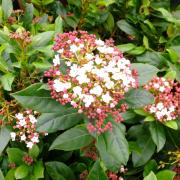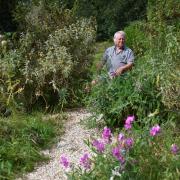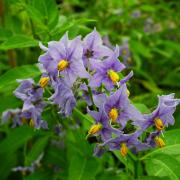Plant specialist Keith Clouting of Taverham Nursery shares his seasonal gardening advice.
Autumn colour
As we move into autumn trees and shrubs such as acer, liquidamber and parrotia provide some exquisite leaf colour in the garden, but when looking for colourful autumn foliage climbing vines are also well worth considering. One of the brightest is Vitis coignetiae , commonly known as the crimson glory vine this vigorous deciduous climber was introduced from Japan in the 19th century. In spring its large heart shaped leaves emerge followed by small green flowers, then at this time of year its foliage starts to turn fiery shades of orange, red and crimson purples looking particularly spectacular with the autumn sun behind them.
Another highly ornamental vine is Vitis vinifera ‘Purpurea’ in spring its emerging young green foliage quickly flushes with bronzy then burgundy hues, darkening to purple as the summer progresses then finally a vibrant crimson in autumn with clusters of small bitter skinned sweet purple grapes which are very attractive to birds to add to the show.
An excellent dual-purpose vine is Vitis ‘Brant’ its green spring and summer leaves colour up well in the autumn with hues of rich reds and orange, the grapes ripen to black and are edible but have several pips, so I leave them on the vine for the added interest and for the birds to feast on. Vitus prefer to grow in good well drained soil in sun or part shade, any pruning to control size should be done in early winter to prevent bleeding from the wounds; plants can also be pinched in summer.

Clerodendron trichotomum var. fargesii ‘Carnival’
This fabulous Clerodendron is one of the most eye-catching small trees with its variegated leaves edged and splashed with cream and light yellow making it really stand out. Its fragrant pollinator friendly white flowers are produced in summer and are followed in late summer and autumn by beautiful striking turquoise blue berries set in deep red calyces. ’Carnival’ will reach 3-4m when fully grown, it’s happy in full sun or dappled shade and thrives in good rich well-drained soil but is drought tolerant when established.

I’m hoping to plant several trees in my new garden, when is the best time for this and are there any pitfalls to avoid?
Pot grown trees can be planted any time of year as long as they are kept well-watered. For bare root trees plant between November and March, but the ideal time for all is in autumn when there is still some warmth in the soil. The most common mistake is planting too deeply, plant at the same level as the tree was growing originally or if this can’t be seen plant to where the roots leave the trunk at ground level.
Make sure the trees you are planting are suitable for your soil or improve accordingly, dig a hole at least twice the size of the root system then when planted give the tree a good mulch, thinner near the trunk then thicker towards the edge forming a saucer shape for watering. Staking is not always required as having movement for the canopy and trunk helps strengthen the tree but is needed where the root-ball may get rocked in the wind breaking the newly formed roots.

Any borderline hardy perennials can be given a good thick mulch now to help protect their crowns throughout the cold winter months.
Yellowing asparagus foliage can be cut back now to around 5cm from ground level, the bed can be weeded at the same time, by hand is best to prevent damaging their shallow roots.
Plant up pots of spring flowering bulbs, these can be used in spring to brighten up dull spots in the garden, or in containers to bring some colour near doorways and paths.
If your greenhouse shading is still in place remove it now to allow the maximum light in over the dull winter months.



























